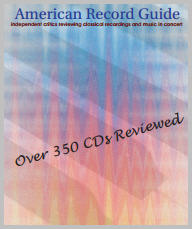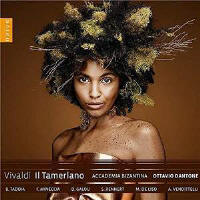Texte paru dans: / Appeared in:
|
|
|
Outil de traduction ~ (Très approximatif) |
|
|
Reviewer: Ralp
Locke Attentive collectors may already own a recording of this opera, a work concocted by Vivaldi for Carnival season in Verona, 1735 (R 703). A previous recording under the remarkable Fabio Biondi was welcomed by John Barker (Sept/Oct 2005). Some arias (e.g., Irene’s ‘Sposa, son disprezzata’) have also been recorded separately by such fine singers as Cecilia Bartoli.
I’m happy to know Vivaldi’s
well-crafted version as well, not least because the current performance is
so stylish, energetic, and generally well tuned. It surely helps that the
recording was made over a period of ten days (in a convent in Ravenna),
rather than on the wing at a stage performance with the singers moving
around and perhaps not always attending primarily to beauty and consistency
of tone. As Reinhard Strohm’s authoritative booklet-essay tells us, Vivaldi
borrowed numerous arias that were associated with two renowned singers of
the day: the super-famous Farinelli and Vittoria Tesi. The latter was a
female contralto renowned for her wide range, perfect intonation (at least
early in her career), and dramatic acuity. She was sometimes called La
Moretta (the Mooress) because her father was of African origin. (He was a
lackey—that is, a liveried manservant—in the employ of a noted castrato.)
Tesi may be the most notable early opera star of African descent. The
borrowed arias are indeed demanding—many of them very showy, others slow and
quite touching. The singers are nearly all up to the task. Some
countertenors take roles that lie a little too low for them, in order to
make sure that they can handle the highest notes. Fortunately, that is not
often the case here with Filippo Mineccia, who brings real bite and flair to
the title role of the Mughul (Turco-Mongol) tyrant Tamerlano, while still
maintaining solid tone, note by note—not spitting consonants out at the cost
of vowels. He certainly never sounds pressed at the top end of his range. I
am delighted to make his acquaintance. The four female singers are generally
fine, and well differentiated in vocal quality, so one can generally tell
who is singing. The two sopranos playing male roles (Marina De Liso and
Arianna Vendittelli) find just the right “tone”, not overdoing the toughness
and thereby spoiling the crucial beauty of voice. The two who get to play
women, Sophie Rennert and Delphine Galou—listed as mezzo-soprano and
contralto—have particularly rich voices. Sometimes one or another of the
female singers sings a bit too fast for comfort or overdoes an aria’s
emotive content, losing momentary clarity of pitch (as in the Idaspe and the
Asteria on Disc 2). This would be acceptable in a performance, but could
easily have been avoided in the studio sessions.
The only real disappointment
is the baritone (Bruno Taddia), in the somewhat secondary role of Bajazet:
his voice is quite weak on the low end, he sometimes semi-shouts (e.g., in
the excellently crafted quartet, borrowed from Vivaldi’s Farnace, Disc 2,
track 21), and his coloratura is huffy (see Disc 2, track 15—a superb aria
of frantic despair by Giacomelli). All of the singers, Taddia included, are
wonderfully communicative in the recitatives, and especially in the several
instances of recitativo accompagnato: that is, recitative accompanied by
fully written out orchestral figuration rather than just chord-based
improvisations from the basso continuo.
The recording is Volume 65 in
the “Vivaldi Edition”, and that Naive series is based on the 450 Vivaldi
works that survive in manuscripts in the National University Library of
Turin. I urge lovers of Baroque music to look out for other releases in the
series. Among other operas of Vivaldi that have appeared in the series, I
might mention Argippo, Catone in Utica, and Farnace. The 2004 Biondi
recording includes an allstar cast: David Daniels, Patrizia Ciofi, Elina
Garanca, Vivica Genaux, and Ildebrando d’Arcangelo—but no libretto. The new
recording is offered at a sensible price, and its thick booklet includes the
libretto in Italian, French, and English. | |
|
|
|
|
Cliquez l'un ou l'autre
bouton pour découvrir bien d'autres critiques de CD |
|




